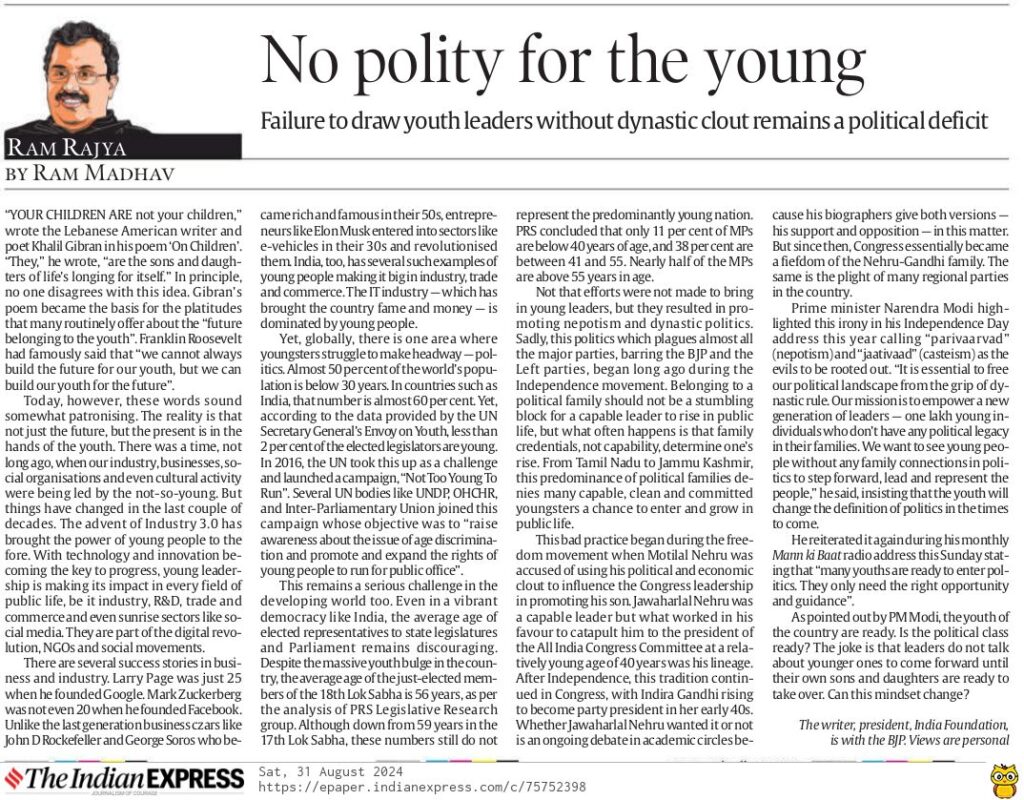
|
Getting your Trinity Audio player ready...
|
(The article was originally published in Indian Express on August 31, 2024 as a part of Dr Madhav’s column titled ‘Ram Rajya’. Views expressed are personal.)
“Your children are not your children,” wrote the Lebanese American writer and poet Khalil Gibran in his poem ‘On Children’. “They,” he wrote, “are the sons and daughters of life’s longing for itself.” In principle, no one disagrees with this idea. Gibran’s poem became the basis for the platitudes that many routinely offer about the “future belonging to the youth”. Franklin Roosevelt had famously said that “we cannot always build the future for our youth, but we can build our youth for the future”.
Today, however, these words sound somewhat patronising. The reality is that not just the future, but the present is in the hands of the youth. There was a time, not long ago, when our industry, businesses, social organisations and even cultural activity were being led by the not-so-young. But things have changed in the last couple of decades. The advent of Industry 3.0 has brought the power of young people to the fore. With technology and innovation becoming the key to progress, young leadership is making its impact in every field of public life, be it industry, R&D, trade and commerce and even sunrise sectors like social media. They are part of the digital revolution, NGOs and social movements.
There are several success stories in business and industry. Larry Page was just 25 when he founded Google. Mark Zuckerberg was not even 20 when he founded Facebook. Unlike the last generation business czars like John D Rockefeller and George Soros who became rich and famous in their 50s, entrepreneurs like Elon Musk entered into sectors like e-vehicles in their 30s and revolutionised them. India, too, has several such examples of young people making it big in industry, trade and commerce. The IT industry — which has brought the country fame and money — is dominated by young people.
Yet, globally, there is one area where youngsters struggle to make headway — politics. Almost 50 per cent of the world’s population is below 30 years. In countries such as India, that number is almost 60 per cent. Yet, according to the data provided by the UN Secretary General’s Envoy on Youth, less than 2 per cent of the elected legislators are young. In 2016, the UN took this up as a challenge and launched a campaign, “Not Too Young To Run”. Several UN bodies like UNDP, OHCHR, and Inter-Parliamentary Union joined this campaign whose objective was to “raise awareness about the issue of age discrimination and promote and expand the rights of young people to run for public office”.
This remains a serious challenge in the developing world too. Even in a vibrant democracy like India, the average age of elected representatives to state legislatures and Parliament remains discouraging. Despite the massive youth bulge in the country, the average age of the just-elected members of the 18th Lok Sabha is 56 years, as per the analysis of PRS Legislative Research group. Although down from 59 years in the 17th Lok Sabha, these numbers still do not represent the predominantly young nation. PRS concluded that only 11 per cent of MPs are below 40 years of age, and 38 per cent are between 41 and 55. Nearly half of the MPs are above 55 years in age.
Not that efforts were not made to bring in young leaders, but they resulted in promoting nepotism and dynastic politics. Sadly, this politics which plagues almost all the major parties, barring the BJP and the Left parties, began long ago during the Independence movement. Belonging to a political family should not be a stumbling block for a capable leader to rise in public life, but what often happens is that family credentials, not capability, determine one’s rise. From Tamil Nadu to JammuKashmir, this predominance of political families denies many capable, clean and committed youngsters a chance to enter and grow in public life.
This bad practice began during the freedom movement when Motilal Nehru was accused of using his political and economic clout to influence the Congress leadership in promoting his son. Jawaharlal Nehru was a capable leader but what worked in his favour to catapult him to the president of the All India Congress Committee at a relatively young age of 40 years was his lineage. After Independence, this tradition continued in Congress, with Indira Gandhi rising to become party president in her early 40s. Whether Jawaharlal Nehru wanted it or not is an ongoing debate in academic circles because his biographers give both versions — his support and opposition — in this matter. But since then, Congress essentially became a fiefdom of the Nehru-Gandhi family. The same is the plight of many regional parties in the country.
Prime minister Narendra Modi highlighted this irony in his Independence Day address this year calling “parivaarvad” (nepotism) and “jaativaad” (casteism) as the evils to be rooted out. “It is essential to free our political landscape from the grip of dynastic rule. Our mission is to empower a new generation of leaders — one lakh young individuals who don’t have any political legacy in their families. We want to see young people without any family connections in politics to step forward, lead and represent the people,” he said, insisting that the youth will change the definition of politics in the times to come.
He reiterated it again during his monthly Mann ki Baat radio address this Sunday stating that “many youths are ready to enter politics. They only need the right opportunity and guidance”.
As pointed out by PM Modi, the youth of the country are ready. Is the political class ready? The joke is that leaders do not talk about younger ones to come forward until their own sons and daughters are ready to take over. Can this mindset change?




